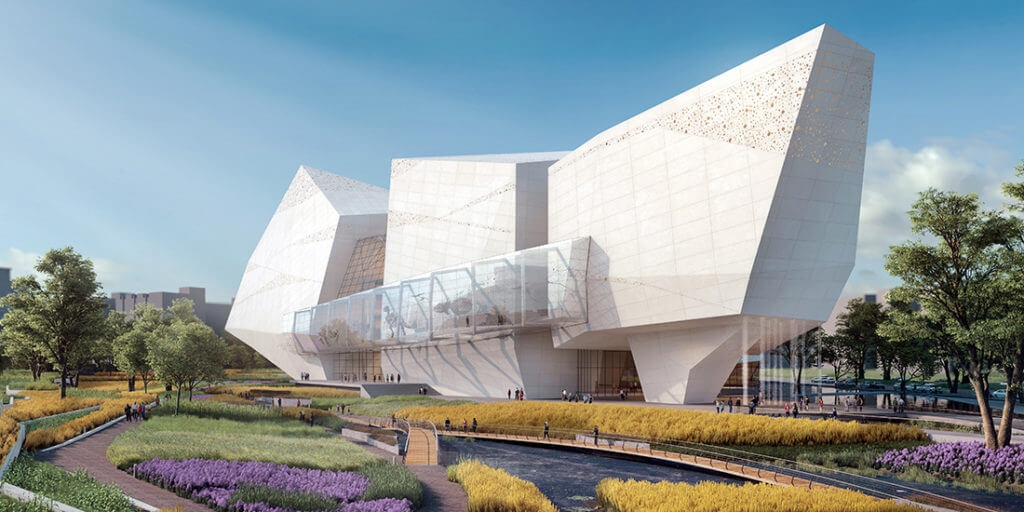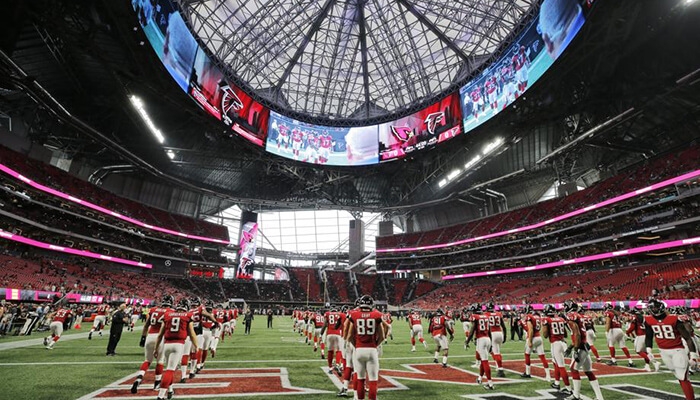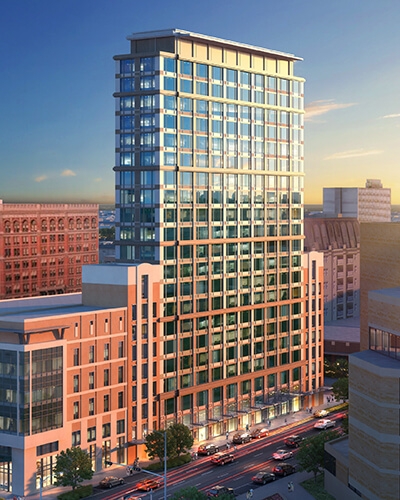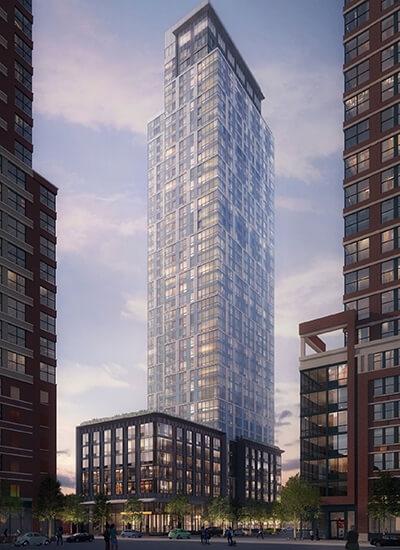6 strategies for challenging the status quo in design-driven engineering
Architects and engineers execute gravity-defying design together—with the former getting the glory. Here are six ways a design-driven engineering firm is rethinking creative collaboration.

Cathy Chatfield-Taylor
October 29, 2019 • 6 min read
The Hatfield Group pioneers in merging architectural creativity with structural engineering to devise support systems for groundbreaking designs, emphasizing collaboration between disciplines.
Using advanced technology and generative design, the firm streamlines the process to efficiently iterate innovative solutions, embodying the essence of design-driven engineering.
Aiming to shift the industry mindset, the team advocates for early collaboration between architects and engineers, fostering innovative and integrated structural solutions.
Ultracreative architects make structures that appear to defy gravity. But how? The answer, in part, is designing underlying support systems that buck the norm. It takes a unique structural engineer to deliver ingenious solutions for outrageous design propositions. Erleen Hatfield is one such engineer.
A licensed structural engineer and a licensed architect, Hatfield was the engineer of record on the iconic Mercedes-Benz Stadium in Atlanta: She captained the team that engineered the first long-span retractable roof to open like a camera aperture. The synthesis of ideas between her team at BuroHappold Engineering and the architects at HOK made the feat possible.
At the peak of her 27-year career, Hatfield has made design-driven engineering the centerpiece of boutique New York City firm the Hatfield Group, which she founded in 2018. If its portfolio of upcoming projects is an indication, challenging the status quo is the rallying cry of this feisty upstart. Hatfield shares a few strategies for disrupting the market and delivering pioneering structural solutions.

1. Partner with an architect
Topping the list is a desire to become creative partners in the design process, rather than by-the-numbers structural engineers. “We want to change the way that architects think about engineering,” Hatfield says. “To do this, we have an architect partner in our engineering firm. I think that is unprecedented and adds tremendous value to our engineering work.”
That partner is Martin Finio, most recently of Christoff:Finio Architecture and a longtime member of the faculty at the Yale School of Architecture. Finio and Hatfield have taught together at Yale for more than 15 years.
To unpack the stereotypes about engineers and architects, Finio says that engineers look at problems as calculations with quantifiable solutions; architects see problems as qualitative, with solutions that are more holistic. He bridges that gap, bringing an architect’s perspective to engineering problems and conveying the engineer’s point of view to clients. (Recent projects that illustrate Hatfield’s collaboration with both owners and architects include the Lied Place Residences in Lincoln, NE, and the 184 Morgan Street residential skyscraper in Jersey City, NJ.)
2. Think like an architect
“Having Martin as part of Hatfield Group helps us think about how we solve engineering problems differently,” Hatfield says. “We want to think more like architects, so we want to start with an open mind and let the architecture drive the engineering work that we do.”
Hatfield challenges her structural engineers to think creatively. “The status quo in design-driven engineering, in our opinion, would be using the same generic engineering thinking on design problems,” she says. “Typically, this is done by following prescriptive design methods and standard approaches. This leads to heavy-handed structural solutions that are often not very elegant.”
When Hatfield Group worked with Pelli Clarke Pelli Architects on the Chengdu Museum of Natural History in China, the team served as a sort of translator for the architect. “We sat down with the people in Pelli’s office and tried to tease out what exactly they were trying to say with the building form,” Finio says. “We asked, ‘What’s the language that you’re operating with?’ And then we found an appropriate structural language to integrate with it.”
Hatfield Group’s input reinforced what the architects wanted to achieve. When they handed off the project to the local engineering firm, China Southwest Architectural Design and Research Institute Corp. Ltd., there was clear direction for executing the structural design.

3. Expect the unexpected
In an industry that expects things to be done the same way every time, it can be hard to do things differently. Making a case for groundbreaking ideas takes patience.
“We try to communicate our engineering ideas in ways that show we’re trying to improve or help the design and mitigate risk or reduce costs,” Hatfield says. “When we really get it right, hopefully all three. It’s about communication and getting everybody on the same page.”
That means lots of face-to-face meetings, listening to everyone’s concerns, and designing a solution that delivers the expected results in unexpected ways.
4. Iterate, then iterate again
Finding different ways to solve challenging problems takes a lot of trial and error. Hatfield Group uses generative design to explore options and discover the best solutions. “You can use Dynamo to create 50 different options,” she says. “You can do all kinds of iterations and generate them very quickly.”
The process saves a tremendous amount of time. Hatfield’s engineers could run through hundreds of solutions in the time it once took to devise two or three.
“Being facile with generative design gives us the ability to go through a lot of engineering work in a far more productive and efficient way,” Hatfield says. “We can test all kinds of configurations rapidly—things like truss sizes or geometry or different materials—to find the answers much faster.”
From a series of floor beams to an entire facade structure, generative design works on the micro and macro levels, allowing engineers to see how whole systems work together.
5. Push the technology
Technology allows Hatfield Group to be more productive and produce better designs, a culture that lets the small firm to play in the big leagues. The team’s approach to software is agnostic: If it works, it uses it. Early in the design process, 3D modeling enables the team to work hand in hand with architects. The engineers then switch to BIM software—Autodesk Revit and Dynamo—for the structural-engineering work.
“We’ve got tools set up to use the best technology for whatever task is at hand,” Hatfield says. If applications don’t play well together, the team writes its own interoperability routines. It also scripts visual programs to try unusual geometries. The time saved means more time for creative pursuits.
“We’re relatively new and not nearly as big as some of the other gigantic engineering firms out there,” she adds. “I feel we can punch above our weight because we can take advantage of a lot of these technology tools.”

6. Change the industry mindset
Iteration is a collaborative process; Hatfield’s team understands that complex projects require considerable back and forth, both internally and with clients.
“We’re very comfortable in that messy space early on, where communication is important,” Hatfield says. “We’re able to clearly articulate our ideas in ways that our clients, the architects, can understand … We’re trying to change the way architects think about engineers. We’re front-end, concept-aware structural engineers working to be an integral part of the design narrative.”
Finio reinforces the idea that structural design is not an afterthought. “You can’t be the kind of engineer who waits until the form of the building has been sorted out, then plug in your engineering,” he says. “We want to be there at the table, at the very beginning. We want to help frame the question—or at least be there to talk about how structure can participate in the question that is being asked.”
About the author

Cathy Chatfield-Taylor
Cathy Chatfield-Taylor is a freelance writer for the architecture, engineering, construction, and technology industries.